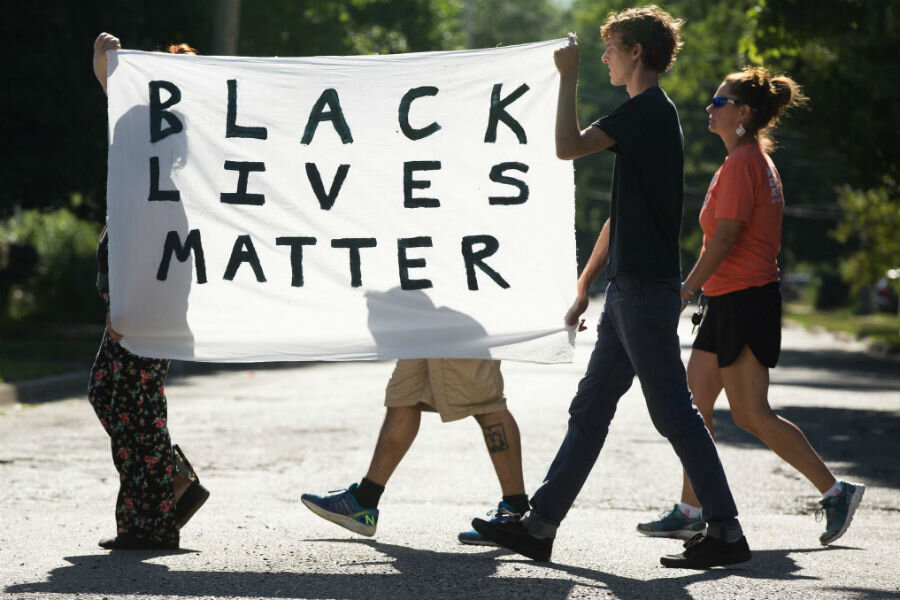Why support for Black Lives Matter has grown among young white Americans
Loading...
As the Black Lives Matter movement spreads to black communities across the world, from Dublin to Amsterdam to Cape Town, support for the movement is also rapidly growing at home among young white Americans.
Fifty-one percent of whites between the ages of 18 and 30 now say they either strongly or somewhat support Black Lives Matter (BLM), according to a recent GenForward survey – a 10-point increase from just three months prior. Forty-two percent say they don't support the movement.
The rising numbers reflect an increased awareness among young white Americans when it comes to issues of racial inequality and police brutality, fueled by recent, highly publicized killings of black Americans by law enforcement. Now, with awareness at an all-time high, many non-black supporters of BLM find themselves asking what kind of role they can – and should – play in the movement.
What "we've been witnessing," says one 30-year-old white Massachusetts activist, who asked to remain anonymous due to death threats after a previous protest, is "a generational shift, a lot of Millennials who are reaching adulthood and realizing that they are now responsible for the world around them... It's a coming of age for a generation that doesn't want to see a lot of the injustices of the past continue."
Jasper Clarkberg, a fourth-year student at Oberlin College in Ohio, attributes the growing number of young white supporters to two factors: "the amazing on-campus organizing led by black and brown activists at college campuses across the US," and "the ability of social media to make abstract injustices very real and quickly spread evidence of racial injustice."
In just the past year alone, a number of on-campus BLM-aligned organizations have launched efforts to highlight injustices and demand changes at their universities. One of the most publicized efforts took place last fall at the University of Missouri, where a group called Concerned Student 1950 held protests in response to acts of racism on campus, resulting in the resignation of the school's president in November.
Some of the shift may be taking place inside the classroom as well, as a growing number of colleges across the country add classes and orientation programs centered around topics of racial identity and privilege.
Dan Fisher, a second-year student at Northeastern University in Boston, cites a class he took last semester on issues of race as one of the reasons why he supports BLM.
"That opened my eyes to a lot of it," he says.
But while the majority of young whites identify as supporters of the movement, for many, that's where their involvement ends.
"I think that's a threshold that a lot of people aren't able to cross, people who support the movement but don't know how to get involved," says the unnamed activist, who has participated in BLM protests.
For white people who are "used to exercising white privilege and taking positions of power and responsibility," the structure of BLM groups with all-black leadership may also be "jarring," he speculates. "It's a bit of a puzzle that a lot of people are figuring out."
Still, Mr. Fisher from Northeastern says, "it's a thing that you should at least support from an ideological standpoint, even if you don't actively go out and protest."
Data from the GenForward poll, however, suggests that white and black people may interpret that ideology in different ways: Whites are more likely to say they believe BLM incites violence against police, and less likely to call the killings of black people by the police a very or extremely serious problem.
Some white supporters question the motivations of other self-identified supporters in joining the movement and wonder whether peer pressure or a desire to earn attention could be playing a role. For Sara Slusarski, a first-year student at Boston's Berklee School of Music, supporting BLM is "common sense." She's glad that awareness is "definitely growing" – but adds that "sometimes it's hard to tell whether people are doing it just because the awareness has grown."
Just as leaders of civil rights groups such as the Student Nonviolent Coordinating Committee (SNCC) and the Congress of Racial Equality (CORE) in the 1960s expressed concerns that the influx of Northern white students coming to the South to participate in the movement could undermine its black leadership and pervert its message, some modern-day BLM leaders say they are similarly concerned about white supporters who may be joining with their own self-interests in mind.
"I think a white person can only be a true ally if she works from the desire to dismantle white supremacy instead of merely being fueled by white guilt," said Katrina L. Rogers, the communications manager of New Orleans’ chapter of BYP100, a black-led activist organization. She told Fusion that she is "never under the assumption" that a white person who identifies as an ally is "invested in my well-being," adding, "if you’re not working with us and taking our direction, you’re not an ally."
Brenna Leahy, a fourth-year student at the University of Notre Dame and Saint Mary's College in Indiana, acknowledges that "white people joining the BLM movement can pose harm if they are doing it for the wrong reasons," noting that "it is important for us to not overtake their movement."
Ms. Leahy and Mr. Clarkberg from Oberlin are among many self-described allies who have taken to campus newspapers and other platforms to advise their white peers on how to constructively use their majority status to support the BLM movement. In a letter published in Notre Dame's campus newspaper, The Observer, Leahy asks her fellow white students to recognize their privilege, practice empathy, and "use our platform to promote social and institutional change."
"Oppression is not something that can be destroyed by the oppressed alone," she tells the Monitor. "It can only be destroyed if us privileged oppressors can work to amplify the voices of the oppressed and end racial injustice."








